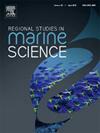巨型海藻固着物大型无脊椎动物群:利用巴塔哥尼亚北部的阿尔法和贝塔多样性实现底栖生物管理和保护
IF 2.4
4区 环境科学与生态学
Q3 ECOLOGY
引用次数: 0
摘要
巴塔哥尼亚北部的奇洛埃内海(ISC)是一个地形和水文异质性区域,由于其密集的底栖手工渔业和水产养殖业,对智利的蓝色经济具有重要意义。本研究利用黄花杉(Macrocystis pyrifera)固着物中的底栖大型无脊椎动物组合,揭示了国际海底科学委员会内部的环境异质性如何以生物形式表现出来。研究考虑了 ISC 从北到南的四个区域(Reloncaví、Chacao、Quinchao 和 Quellón),其中有五个采样点。分析了不同区域和地点之间 200 个海带固着层(每个区域 50 个)中大型无脊椎动物的密度、组成、物种/类群丰富度(S)、香农多样性(H´)和总体贝塔多样性(βsor)的空间变异性。方差分析结果表明,海带固着体的大小、区域和区域内的地点解释了密度、S 和 H´ 的变化。Tukey HSD 检验也表明,采样区和采样点之间存在显著差异(p < 0.01)。分布模式包括:i) 密度从 ISC 北部向中心纬度增加(最大值为 67 ind 10 cm-2,Quinchao);ii) 北部 S 值较高(最大值为 37,Reloncaví);iii) H´ 纬度降低(最大值为 3.2,Reloncaví);iv) 南部(Quellón)所有生态属性值较低。总体贝塔多样性分析(βsor)显示,各区内部的变异性很大,主要是受物种更替(βsim)而非物种嵌套性(βsne)的驱动。PERMANOVA 分析表明,大型无脊椎动物的组成模式与固着体大小和采样地点/区域有显著相关性(p < 0.01)。SIMPER 分析表明,有环类动物、节肢动物和软体动物对不同区域间的差异做出了贡献。结果凸显了 ISC 的生物异质性,表明特定地点的环境条件会影响 M. pyrifera 的种群,进而影响栖息在其固着层中的大型无脊椎动物。这些发现有助于更好地了解该地区生态的复杂性,为今后研究底栖生物群落的现状和组成,进而管理和保护底栖生物群落提供了基线。本文章由计算机程序翻译,如有差异,请以英文原文为准。
The giant kelp holdfasts macroinvertebrate assemblages: Towards benthic management and conservation using alpha and beta diversity in Northern Patagonia
The Inner Sea of Chiloé (ISC), northern Patagonia is a topographically and hydrographically heterogeneous area of critical interest to the Chilean blue economy due to the intensive artisanal benthic fisheries and aquaculture practices. Using benthic macroinvertebrate assemblages from Macrocystis pyrifera holdfasts, this study exposes how environmental heterogeneity inside the ISC can also be expressed in biological terms. Four zones were considered in the ISC from north to south (Reloncaví, Chacao, Quinchao, and Quellón), with five sampling sites within them. The spatial variability of macroinvertebrate density, composition, species/taxa richness (S), Shannon´s diversity (H´), and overall beta diversity (βsor) in 200 kelp holdfasts (n =50 per zone) between zones and sites were analyzed. ANOVA results showed that the holdfast size, zones and sites within zones explained the variability of density, S and H´. Tukey HSD test also indicated significant (p < 0.01) differences between sampling zones and sites. Distribution patterns included: i) a latitudinal increase in density from the north to the centre of the ISC (max. of 67 ind 10 cm−2, Quinchao); ii) higher S values in the north (max. of 37, Reloncaví); iii) a latitudinal decrease in H´ (max. of 3.2, Reloncaví); iv) lower values for all the ecological attributes in the south (Quellón). Overall beta diversity analysis (βsor) showed high variability inside each zone, mainly driven by species turnover (βsim) rather than species nestedness (βsne). nMDs analysis suggested that the northern zones of ISC can be considered the same and differentiated from the others, but they are highly variable within them. PERMANOVA analysis showed that the macroinvertebrates' composition patterns were significantly (p < 0.01) explained by the holdfast size, and sampling sites/zones. SIMPER analysis revealed the contribution of annelids, arthropods, and molluscs to dissimilarities between zones. The results highlighted the biological heterogeneity of the ISC, suggesting that site-specific environmental conditions affect M. pyrifera populations and, therefore, macroinvertebrates inhabiting their holdfasts. These findings contribute to a better understanding of the ecological complexity of the region, providing a baseline for future studies on the status and composition of benthic communities, and therefore their management and conservation.
求助全文
通过发布文献求助,成功后即可免费获取论文全文。
去求助
来源期刊

Regional Studies in Marine Science
Agricultural and Biological Sciences-Ecology, Evolution, Behavior and Systematics
CiteScore
3.90
自引率
4.80%
发文量
336
审稿时长
69 days
期刊介绍:
REGIONAL STUDIES IN MARINE SCIENCE will publish scientifically sound papers on regional aspects of maritime and marine resources in estuaries, coastal zones, continental shelf, the seas and oceans.
 求助内容:
求助内容: 应助结果提醒方式:
应助结果提醒方式:


